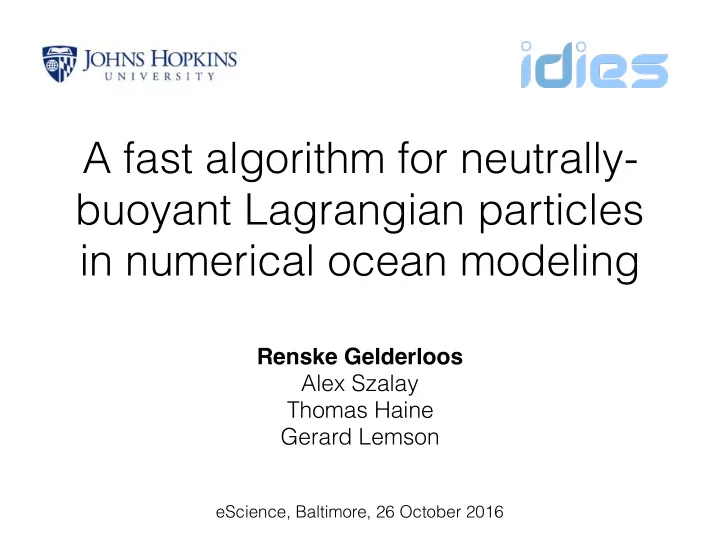

A fast algorithm for neutrally- buoyant Lagrangian particles in numerical ocean modeling Renske Gelderloos Alex Szalay Thomas Haine Gerard Lemson eScience, Baltimore, 26 October 2016
Ultra-high-res. ocean models are now highly realistic, revealing, About 10 10-11 numbers per snapshot 10 3-6 snapshots stored per run = 10 13-17 nos. per run Source: Chris Hill, MIT, http://mitgcm.org, Haine, 2010.
and need good tools for post processing Gelderloos et al., 2016b Origin Temperature Salinity Depth
Lagrangian particle models Two types of offline Lagrangian particle-tracking models available: 1. Analytical models : Very fast, but assume stationarity between model samples —> inaccurate 2. Numerical model : CMS most widely used example, needs Unix and unphysical solid boundary conditions Our code is numerical with correct boundary-sliding conditions, but very slow —> needs speeding up
Old implementation Koszalka et al., 2013
Old implementation Four stages: 1. Initialization : model domain, grid, bathymetry and initial particle positions
Old implementation: Step 1 Load grid and bathymetry info NZ NY NX
Old implementation: Step 1 Load grid and bathymetry info NZ Seed particles in the domain NY NX
Old implementation Four stages: Four stages: 1. Initialization : model domain, grid, bathymetry and initial particle 1. Initialization : model domain, grid, bathymetry and initial particle positions positions 2. Calculate particle trajectories : for predetermined length of time, trajectory is calculated based on ocean model velocity fields
Old implementation: Step 2 Load 2 sequential 3D velocity fields NZ Create a local environment around the particle (necessary for old interpn function) NY NX
Old implementation: Step 2 Calculate next piece of the trajectory NZ NY Explicit Runge-Kutta (2,3)-pair ODE solver for moderately stiff problems NX
Old implementation: Step 2 Step forward NZ NY NX
Old implementation: Step 2 Interrupt if: 1) particle moves to another cell 2) particle hits the NZ bathymetry NY NX
Old implementation: Step 2 Interrupt if: 1) particle moves to another cell NZ Get new local NY neighborhood NX
Old implementation: Step 2 Interrupt if: 2) particle hits the bathymetry Switch to along-bathymetry sliding mode
Old implementation: Step 2 Sequential implementation because: • Required to handle small neighborhoods (because interpn used to be very sensitive to cutout size) • Timings of interrupts are unknown a priori
Old implementation Four stages: 1. Initialization : model domain, grid, bathymetry and initial particle positions 2. Calculate particle trajectories : for predetermined length of time, trajectory is calculated based on ocean model velocity fields 3. Particle property extraction : Temperature/salinity along trajectory are found by interpolation of model T/S fields
Old implementation: Step 3 Load sequential property NZ fields and interpolate NY NX
Old implementation Four stages: 1. Initialization : model domain, grid, bathymetry and initial particle positions 2. Calculate particle trajectories : for predetermined length of time, trajectory is calculated based on ocean model velocity fields 3. Particle property extraction : Temperature/salinity along trajectory are found by interpolation of model T/S fields 4. Particles positions and T/S info saved for further analysis
Old implementation: Step 4 Save time series of particle locations and properties
Old implementation Four stages: 1. Initialization : model domain, grid, bathymetry and initial particle positions 2. Calculate particle trajectories : for predetermined length of time, trajectory is calculated based on ocean model velocity fields 3. Particle property extraction : Temperature/salinity along trajectory are found by interpolation of model T/S fields 4. Particles positions and T/S info saved for further analysis Large potential gain by vectorization & parallelization of steps 2 and 3
New implementation Gelderloos et al., 2016a
Interpolation improvements (I) CPU : local small array no longer necessary GPU : requires loading data into GPU memory —> faster for >1000 particles
Interpolation improvements (II) Removed cell boundary interrupts: (1) Faster (2) More accurate NZ (3) Simpler code NY NX
Interpolation improvements (III) Vectorization of ocean-floor impingement interpolations yields a 160x speedup for 10 6 particles (Cubic interpolation only possible in CPU)
Bucket-List Algorithm 3D 2D 3D
Parallelizing part 3 Vectorization and parallelization (with parfor ) 0: original 1: native little endian + fread 2: vectorized 3: parallelized C/W: cold/warm cache 40 particles test case yields 10x speedup
Planned improvements Speedup: 1. Implement Bucket-List algorithm 2. Use sparse array (disregard grid cells under the ocean floor) 3. Use databases and space-filling curves Accuracy: 1. Use different ODE solver for interior and boundary-sliding particle trajectories (with different tolerance settings)
Conclusions • We built a particle-tracking code with accurate boundary-sliding representation • Vectorization of the particle-tracking part of the algorithm has yielded a 3500 times speedup for 10 3 particles (5000 for 10 6 particles) • Vectorization of ocean-floor impingement has yielded an additional factor 6 for 10 3 particles (160 for 10 6 particles) • Vectorization/parallelization of the property-extraction part of the algorithm has yielded a 10x speedup for 40 particles
Future Work • Make the particle-tracking algorithm publicly available • Improve the back-end database environment • Enhance post-processing functionality • Scale up to benchmark global ocean circulation solution Koszalka et al., 2013; Magaldi & Haine, 2016
Recommend
More recommend